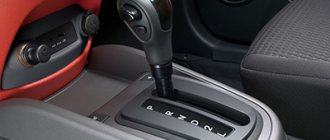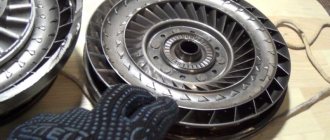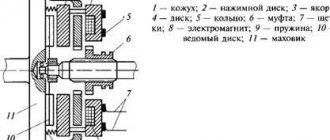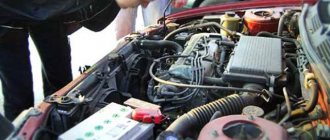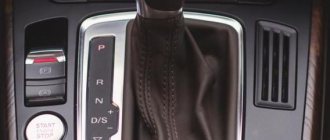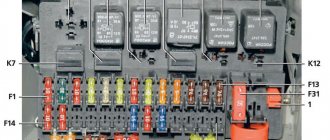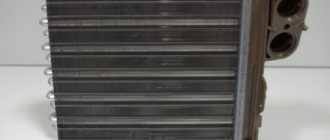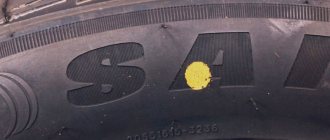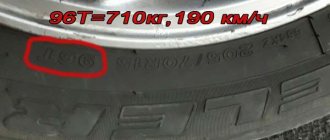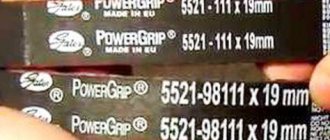I. CLASSIC AUTOMATIC (AT).
It always has a torque converter (hereinafter referred to as GT) and a set of planetary and gear mechanical gears. The gear ratio is changed by oil pressure in the GT and different gear connections. Automatically controlled.
Main operating modes:
As for operating modes, almost any automatic transmission has the following modes, which have become standard since the late 1950s:
“P”
(English: “Park”) - parking lock (the drive wheels are blocked, the lock is located inside the automatic transmission itself and is not associated with the normal parking brake);
“R”
(English: “Reverse”) (on domestic models - “Zx”) - reverse gear (it is unacceptable to engage until the car comes to a complete stop; on modern transmissions there is often a lock);
"N"
(English: "Neutral") (in domestic - "N") - neutral mode (turns on during short-term parking and when towing a short distance);
“D”
(English: “Drive”) (in domestic - “D”) - forward movement (as a rule, all stages are used, or all except overdrive gears);
“L”
(English: “Low”) (in domestic versions - “PP” (Forced Downshift) or “Tx”) - low gear, “quiet running” (for driving in difficult road conditions).
Additional operating modes:
In modern automatic transmissions, with a large number of operating ranges, additional operating modes may be present, and the selector positions may be designated differently:
“[D]”
or “OD” - overdrive (a stage with a gear ratio of less than one), driving mode with the ability to automatically switch to overdrive.
Most suitable for uniform movement along the highway; “D3”
or “O/D OFF” - only 1st, 2nd and 3rd gears, or disabling overdrive (overdrive).
Active mode, most suitable for city driving; “S”
(or number “2”) - range of low gears (I and II or only II gear).
"Winter mode"; “L”
(or number “1”) - second range of low gears (1st gear only).
Also, there are additional switches (implemented, for example, in the form of buttons) for automatic transmission operating modes: “Sport”
or
“Power”
- gear changes occur at higher engine speeds.
More dynamic acceleration at the expense of fuel consumption; “Winter”
or
“Snow”
- starting from third gear (to prevent wheel slipping); due to possible overheating of the gearbox, it is not recommended to constantly drive in this mode.
In some cases, Sport
is activated automatically when you press the gas pedal deeply - the so-called.
"kickdown
" In some cases, kickdown mode is disabled when Overdrive is disabled.
Unlike manual transmissions, automatic transmissions do not support engine braking in all modes. In modes where engine braking is prohibited, the transmission slips freely in the overrunning clutches (like in a bicycle) and the car coasts. For example, in some cases, first gear with engine braking is only engaged when the driver selects position “1”. When selecting first gear automatically from position “D”, engine braking is impossible.
Automatic transmission increases driving comfort. The absence of the need to select the desired gear and change gears allows you to concentrate on driving, which in a difficult road situation will not interfere with even an experienced driver.
Thanks to the presence of a torque converter, the automatic transmission creates more favorable operating conditions for both the engine and the chassis, which increases their service life, and the automatic transmission control system prevents overloads of the engine and chassis of the vehicle due to driver errors.
A car with an automatic transmission is equipped with a passive safety system that does not allow the engine to be started in positions other than “P” and “N”. It also prevents spontaneous movement of the car when parked on an uneven surface, because You can remove the key from the ignition switch only in the RVD position “P”.
The disadvantages of automatic transmissions include lower efficiency (due to losses in the torque converter) than that of a manual transmission, which increases fuel consumption. Although this is not always the case.
Modern automatic transmissions in some driving modes make it possible to achieve higher efficiency compared to manual transmissions by maintaining optimal engine speeds and “intelligent” control of torque converter lock-up.
Another drawback is that the dynamic acceleration performance of a car with an automatic transmission is slightly worse than with a manual transmission, all other things being equal. The difference is not so great and is insignificant for the majority of drivers.
And finally, a car with an automatic transmission cannot be started except with the help of the starter. It should be noted that the overwhelming number of drivers who have experience in operating both types of transmissions, regardless of their level of income and driving experience, give unconditional preference to cars with automatic transmission.
Recently, many innovations have appeared to make working with the machine more convenient:
a)
Adaptive automatic transmissions. The development of “electronic” automatic transmissions has led to the emergence of adaptive gearboxes. The control algorithms being developed are becoming more and more intelligent, which leads to the emergence of new quality in the same transmissions, from a mechanical point of view.
The on-board computer monitors the driver's driving style and adjusts accordingly. In addition, the operating algorithm of such a computer takes into account the wear of friction control elements in the automatic transmission. All this leads not only to an increase in the comfort of traveling by car, but also to an increase in its service life and efficiency.
b)
Autostick (Steptronic, Tiptronic). This is a system for controlling the operation of an automatic transmission, in which, along with automatic, there is also a semi-automatic control mode, in which the driver gives the command to shift gears, and the quality of these shifts is ensured by the control system.
Depending on the manufacturer, this mode has different names (Autostick, Steptronic, Tiptronic); it is implemented only on cars that have an electronic automatic transmission control system, and even then not on all.
In cars equipped with such a system, the RVD has a special position in which the Autostick mode is activated. Regarding this position, there are two opposite, non-fixed positions of the RVD.
These positions are designated “+” (“Up”) and “-“ (“Dn”), respectively for shifting to a higher or lower gear. Autostick mode is more semi-automatic than manual, because... The transmission computer does not cease to monitor the driver’s actions and will not allow him, for example, to start from a higher gear, or select a gear in such a way that the engine speed exceeds the permissible limit.
Otherwise, it’s a complete illusion of a mechanical transmission. At the driver’s request, you can switch to the normal automatic control mode by moving the RVD to position “D”.
c)
Modes: economical, sport, winter. The economical program is configured to ensure movement with minimal fuel consumption. The movement of the car in this case is smooth and calm.
The sports program is tuned to maximize engine power. In this case, the car develops significantly greater acceleration compared to the economical program.
The winter program starts off on a slippery road. In the case of its operation, various algorithms for the operation of the automatic transmission are possible, but, as a rule, in all cases, starting is carried out either from the second or from the third gear.
d)
Kickdown mode. If you press the gas pedal all the way while driving, the gearbox will shift down one or two gears.
This mode is recommended for faster overclocking. Reverse upshifting in this case can only occur when the engine reaches maximum speed.
SHORT:
Inside the car there is an automatic transmission that clearly changes gears depending on the number of revolutions.
How does the robot box behave?
Operating principle of robotic boxes
the gears are absolutely the same.
The only difference is that servos—actuators—are responsible for closing/opening the clutch and selecting gears in the “ robot
.” Most often this is a stepper electric motor with a gearbox and an actuator. ... Then the first one smoothly releases the clutch.
Interesting materials:
How to make the correspondence deleted from the interlocutor on WhatsApp? How to prevent pizza from being dry? How can I make Google open when I open a new tab? How can I prevent tabs from closing when I close Google Chrome? How to prevent rice from being dry? How to make the site remember the password on the iPhone? How to prevent Siri from saying who's calling? How to get unblocked on WhatsApp? How to make yourself respected? How to make sure that telephone conversations are recorded?
Design and principle of operation
Many users do not fully understand the operating principle of the robotic box, considering it a complex mechanism. Structurally, the Lada 5 AMT gearbox is nothing more than a 5-speed manual gearbox, controlled by electronics.
So, let’s look at what 5 AMT is in detail. A detailed examination of the box produced by AvtoVAZ PJSC indicates that a standard mechanical-type automated transmission scheme is used using one disc in the friction clutch design.
The layout looks like this:
- Box clutch;
- Variable gearbox, mechanical type;
- Gearbox and clutch drives;
- Box control module.
A special device, mechatronics, is responsible for controlling the gears. Since it is a set of control elements in the form of sensors and electronics, the design does not provide mechanical connections for shifting gears.
It includes:
- Variable gearbox speed sensor on the input shaft;
- Gearbox mode control selector;
- An actuator that controls gear shifting and clutch release;
- Gearbox controller.
The gearbox operates in one of two modes: automatic and semi-automatic. Receiving information from sensors, in automatic mode the box changes gears without driver intervention. Gears are switched using software and signals from the control module. In manual mode, gears are changed by the driver using the shift lever. Move forward, upshift, move backward, downshift.
Since 2012, Lada cars have been equipped with the Japanese 4 AT gearbox, produced by Jatco. This is a classic four-speed automatic transmission equipped with a hydraulic transformer. Buyers were faced with the question, 4 AT or 5 AMT, which is better, what to choose and how will this affect further operation? The automatic transmission had a number of advantages related to smoothness and comfort. However, there were more disadvantages: increased fuel consumption, expensive and complex maintenance. Over time, the robot became popular among car enthusiasts.
5 AMT transmission service
According to the manufacturer, the 5 AMT transmission does not require maintenance, its elements are protected from dust and moisture, which in turn has secured the transmission’s reputation as a simple, reliable, trouble-free mechanism.
However, it is recommended to adhere to the following rules:
The box is a set of gears controlled by a ZF actuator. The clutch of the box wears out over time and needs to be adjusted to the actuator, this process is called adaptation, it is designed to eliminate jerks and shocks when moving.
Adaptation is carried out:
The process is simple and takes a few minutes: the car is connected to the AvtoVAZ computer through a special diagnostic connector, the electrician turns on the program and directly communicates with the manufacturer’s server. The data is downloaded to the server, after which the engine starts and adaptation occurs within a few seconds.
It is advisable to have the box diagnosed by an official representative, since the work will require special equipment and trained personnel.
What does the AT mark on tires mean?
The abbreviation AT is applied to the side of the tire in two versions. The manufacturer may mark the model as A/T or AT. Regardless of the method of application, the essence of the designation does not change. Literally, the letters AT stand for all terrain, that is, a tire with this marking is suitable for driving on any type of road surface. Design engineers think through the tread in such a way that the car can easily overcome country roads, pebbles, unstable soil and does not make noise on an asphalt road.
This option is chosen by motorists who are ready for compromise solutions. AT rubber does not demonstrate ideal performance on any one surface, but performs the same on each of them. The tread pattern has a pronounced “off-road” character: large blocks, wide longitudinal and transverse grooves for draining water and dirt, wide sidewalls. If we look at the tread in more detail, we can see solutions often used for winter, road and even rain tires.
Another nuance - most tires marked AT have another symbol in the form of the abbreviation M+S (off-season option). Such tires are something like 3, 4 or even 5 in 1. That is why experienced drivers advise not to place high hopes on them, so as not to be disappointed later. Universal options are not a magic solution, not a panacea and not a way to save for years. After several seasons of aggressive use, the tread gradually wears out and cannot guarantee the preservation of its original properties.
In addition, in harsh regions, the rubber mixture hardens quickly, so it is not recommended to use it for movement. This is life-threatening. You should not choose tire models marked AT and M+S in the hope of saving all your hard-earned money, and then drive through snowdrifts in severe frost. Tires of this type perform best when 75% of the time is spent on roads of even average quality, and not on wet clay tracks or dirt roads.
Which car gearbox is right for you | Fox Drive
Which gearbox on a car is right for you
If you decide to buy a car, but don’t know which gearbox ( gearbox
) to choose or you are simply wondering what is the difference between them, then I hope this article will help you figure it out.
I will not overburden you with the technical side of each type of gearbox
, but I will try to
simply
and
clearly
explain the features of each of them, the pros and cons, and the best operating conditions.
Let's start with an easy theory.
.
The gearbox
serves to connect the car’s engine to the wheels; it is through it that all power and torque are transmitted.
main types of civilian gearboxes
: mechanical, automatic hydraulic (classic), automatic variator, automatic robotic.
You may also hear the word transmission
, this is another name
for checkpoint
.
Types of checkpoints
often referred to as:
MT, AT, CVT, AMT.
Go
Manual Transmission (MT)
Which car gearbox is right for you?
Let's start with the simplest and most understandable gearbox
.
This is the same option with three pedals: gas, brake and clutch, which you need to squeeze every time you want to change gear.
At what speed of all those presented at the checkpoint
to drive is completely under the control of the driver. Modern cars usually have 5-6 speeds.
Every year cars with manual transmission
Selling less and less, because not everyone likes to press the third pedal with the second foot and pull the gearbox handle.
Typically, drivers want to get to their destination calmly and comfortably without thinking about any switching. But of course, there are also car enthusiasts who like to have full control of their car, which is what a manual transmission
.
pros
The advantages of this type of gearbox
This includes its simplicity and reliability, low maintenance cost, and the ability to tow for a long time without overheating (for example, in snowy yards in winter). And of course, full control of the car’s dynamics for special connoisseurs. Also, one of the advantages is low fuel consumption, but all this is relative, it depends on your driving style, if you turn at maximum torque or at high speeds, there will be no savings.
And constantly driving to save money at low speeds and switching to higher speeds early, in my opinion, can be a little annoying, constantly looking at the tachometer, pressing the pedal and pulling the handle.
Minuses
The main disadvantage is the inconvenience of use in city mode. In traffic jams, frequent switching can get pretty boring. Also for beginners this checkpoint
may seem difficult to control; press the clutch pedal inaccurately and the car will stall.
Best operating conditions
M.T.
— is a universal transmission and is suitable for use in any conditions (city, highway, off-road). Another thing is that it won’t be comfortable to drive everywhere, but in terms of reliability it will withstand anything. You can safely tow both the car itself and the cargo on it.
By the way, in the USA, about
95% of cars drive with automatic transmissions , and manual transmissions are considered the lot of fans and professional racers. If you are not one of them, then it is better to choose automatic transmissions .
Automatic hydraulic transmission (AT)
Which gearbox on a car is right for you
? This transmission option already provides the same comfort of movement when you can not be distracted by switching, but completely concentrate on the road. The driver gets much less tired in city traffic compared to MT
on which you need to squeeze the clutch, change gear, smoothly release the clutch while simultaneously pressing the gas pedal.
So many movements! And they will be repeated at every traffic light, with every traffic jam. It's either automatic. I put the selector in “drive” mode and you don’t have to worry about anything. But there is also a manual mode, although it is more simplified compared to manual transmission
.
pros
Ease of control, many modern cars have a choice of automatic transmission operating modes: eco for fuel economy, normal for normal driving and sport where you can “pile up”, so to speak. The desired operating mode of the engine and automatic transmission
The electronics will support you, all you have to do is step on the gas and steer.
We can also say that, in general, such boxes are quite reliable if used correctly and properly maintained.
Minuses
The disadvantages include the higher cost of the gearbox
, and ultimately the cars, as well as the cost of maintenance. But I believe that you can pay extra for comfort; as a rule, the amounts are not so significant.
Best operating conditions
It copes well with both the city and the highway, but it’s better to drive more carefully off-road, some gearboxes can overheat, although in general you can skid on it for a short time. Also read the instructions for your car if you want to tow a trailer. If the car itself breaks down, it is better to transport it on a tow truck.
Automatic robotic gearbox (AMT)
Which gearbox on a car is right for you?
The peculiarity of this transmission is that it is essentially mechanical, but the gears themselves are switched by a robot (electronics). In terms of convenience, it is similar to a classic machine gun. You also turn on the drive mode and drive without thinking about switching.
All the features that I write here are related to AMT
with double clutch such as the well-known
DSG
from
VAG
or
Power Shift
from
Ford.
This type of robotic gearbox is currently the most advanced in terms of efficiency and shift speed.
pros
Convenience and comfort of control. Faster gear shifting and acceleration compared to MT
or
AT.
High fuel economy, which reaches
10%
compared to other types of transmissions.
Minuses
The main disadvantage of AMT
is its reliability. Many owners contacted the service with low vehicle mileage, about 50,000 km. Also, the disadvantages include expensive repairs and maintenance of some models of these boxes.
Best operating conditions
I would say that this box is not for city driving with its traffic jams. When driving in the city, the gearbox overheats and its components fail faster.
Also, you should not skid or drag trailers on it.
But the robotic gearbox
feels good on highways where gear changes are rarer and thus the gearbox does not overheat. If the main place where your car is used is on the highway, then you can safely take a car with this transmission.
Automatic transmission CVT (CVT)
Which gearbox on a car is right for you?
The main difference and feature of this gearbox
from others, it is the lack of speeds. This has both its pros and cons. The transmission is also automatic, so you can enjoy driving the car using only two pedals. The best thing about this box will be its pros and cons, so let's get to them.
pros
A car with such a transmission accelerates easily, smoothly, acceleration occurs without the slightest jerks, which can be felt to one degree or another on other types of automatic transmissions, including even the newest ones. Also among the advantages it is worth highlighting fuel economy compared to AT
, better distribution of the load on the engine, which allows you not to overload the power unit and increase its service life.
Minuses
This type of box has a noticeably shorter service life compared to the same AT
, as well as low maintainability, high maintenance costs and a number of restrictions during operation.
At such a gearbox,
you need to accelerate smoothly, gradually increasing engine speed.
Best operating conditions
CVT
Unlike
AMT,
it is best suited for urban operation. This is due to the fact that when the engine is at high speeds for a long time, this gearbox is prone to overheating and, accordingly, breakdown. Therefore, cars with CVTs are perfect if most of the time you drive the car in the city where the average speed is much lower than on the highway. CVT is also very sensitive to slipping and additional loads in the form of trailers.
Thank you for your attention, if you liked the article, subscribe to the
channel , like it, so I will understand that you are interested and I will write something else :)
Volume units
What do the letters on an automatic transmission mean
? A ton of displacement is a unit of volume used to calculate the displacement of a boat. When displacement is the carrying capacity of a ship, it means the volume of water displaced by the ship, multiplied by its density and measured in English tons (tons of displacement). A ton of displacement is a volume of water weighing one ton. This is equivalent to about 0.97 m³ of water.
One freight ton is about 1.13 m³. It shows the volume of a truck, train or other means of transportation. Previously used for ships, now a registered ton is used, which corresponds to 2.83 m³.
Previously, the unit of measurement used in the UK was the water ton, which was equivalent to 1.02 m³. This was the volume occupied by the mass of one English ton of water.
Advantages and disadvantages
Comparing the transmission with other representatives of automatic transmissions, we can highlight both positive and negative features of the box.
Advantages of the 5 AMT unit:
- Reduced fuel consumption, performance comparable to a 5 MT manual transmission;
- Low cost of spare parts and labor in case of gearbox repair;
- The design of the box allows you to tow the car using a cable or a rigid hitch;
- If the battery loses power, the box allows you to start the car from a pusher;
- The friction disc and gearbox lubricants are designed for the entire service life of the product;
- Protection of the box from incorrect switching, which avoids damage;
- The box has automatic and manual gear shifting;
- Smooth operation of the gas pedal facilitates the transition from gear to gear without jerks or failures;
- Switching occurs in a short period of time, within 120 ms;
- The presence of an automatic algorithm that allows you to start moving the machine while on an inclined surface.
Disadvantages present in the operation of the box:
- Since the gearbox is designed to use a clutch with one disc, this leads to loss of traction when shifting;
- It is not possible to use sports driving of the car, since the gearbox gives a smooth response when you press the gas pedal sharply;
- There is no way to forcefully equalize the speed of rotation of the gearbox shafts by manipulating the gas pedal;
- The absence of steering wheel switches, with which you can quickly change the algorithm of the gearbox.
The history of manual transmission development, from Ford T to Bugatti Veyron
Since the appearance of the first car to the present day, designers have used the following types of manual transmissions:
- A 2-speed planetary gearbox was installed on the famous Ford T, whose production began in 1908.
- The 3-speed manual transmission appeared in 1920. It existed until the end of the 60s of the twentieth century. Found on rare cars in private collections.
- The four-speed manual transmission was born only three years later than the three-speed one. But due to the lack of synchronizers, it did not withstand shock loads well when used by an inexperienced driver. Most manufacturers installed a three-speed manual transmission on their cars; a four-speed manual transmission was considered a sports option.
- The five-speed gearbox appeared in the 70s of the last century, and ten years later it was equipped with the vast majority of passenger cars.
- 6, 7, 8-speed gearboxes have been developed since 2000, and are currently installed on Elite class cars. For example, a 5-speed gearbox equipped with two additional Overdrive gears is found on the BMW M5.
The VAZ robot AMT has been updated. Now we know everything about him!
The Lada Brand Day event was held in Sochi, where the VAZ team presented an updated robotic transmission. This is what AMT project manager Vladimir Petunin told ZR:
Vladimir Petunin, AMT project manager
Vladimir Petunin, AMT project manager
AVTOVAZ models that are equipped with a robotic gearbox.
AVTOVAZ models that are equipped with a robotic gearbox.
AMT robotic gearbox diagram
AMT robotic gearbox diagram
It just so happened that there were a lot of complaints about AMT. Like, the driver and passengers nod when switching, the car becomes dull, and so on. The VAZ team listened and even offered several new firmwares, but the global update was announced only now.
No fundamental changes to the actuators were required. However, there are still innovations in the hardware - the control controller now has not one, but two boards, and, of course, a different transmission control program. So owners of robotic cars will not be able to simply come to the dealer and reflash the box.
What did they change?
The “traffic” mode, or, as it is officially called, the Creeping mode function, which appeared this year, has been retained. The driver simply takes his foot off the brake pedal and the car begins to roll forward. The speed in first gear is 7–8 km/h, in second gear it is 14–15 km/h. When you engage reverse, this mode also works - the car crawls at a speed of 5–6 km/h.
In this case, the Creeping mode function is turned off automatically under one of three conditions: if you open the driver's door while driving, if you move the selector to neutral or tighten the parking brake handle. That is, suddenly the car won’t move on its own.
The new AMT control program has reduced the gear shift time: from first to second and from second to third - by as much as 30%. They promise that the synchronizers will hold up.
The new AMT control program has reduced the gear shift time: from first to second and from second to third - by as much as 30%. They promise that the synchronizers will hold up.
5 AMT transmission service
According to the manufacturer, the 5 AMT transmission does not require maintenance, its elements are protected from dust and moisture, which in turn has secured the transmission’s reputation as a simple, reliable, trouble-free mechanism.
However, it is recommended to adhere to the following rules:
The box is a set of gears controlled by a ZF actuator. The clutch of the box wears out over time and needs to be adjusted to the actuator, this process is called adaptation, it is designed to eliminate jerks and shocks when moving.
Adaptation is carried out:
The process is simple and takes a few minutes: the car is connected to the AvtoVAZ computer through a special diagnostic connector, the electrician turns on the program and directly communicates with the manufacturer’s server. The data is downloaded to the server, after which the engine starts and adaptation occurs within a few seconds.
It is advisable to have the box diagnosed by an official representative, since the work will require special equipment and trained personnel.
